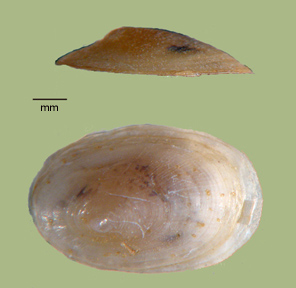> Habitat & Distribution
Basch (1963) gave the American range of Hebetancylus excentricus as Georgia, Florida and Texas only. It was first reported in South Carolina by Harrison (1989). Here we extend the range of H. excentricus to include spotty records from ponds and river backwaters up the length of the southern Atlantic Coastal Plain. Populations are locally common on submerged sticks, logs, and large items of organic debris. Such a contagious distribution suggests dispersal by migratory waterfowl. FWGNA incidence rank I-3p, peripheral.
> Ecology & Life History
Turner & Corkum (1979) reported simple annual life cycles in several Louisiana populations of Hebetancylus (type A of Dillon 2000: 156-162), one bivoltine (type C) population and one trivoltine (perhaps Esii). Other life history observations are available in McMahon (1976). Harrison (1989) reported that some of the individuals he collected from his South Carolina were septate, suggesting that they may have passed a period of dry or otherwise harsh environmental condition in aestivation.
> Taxonomy & Systematics
The presence of an apex distinctly off midline is generally considered diagnostic for this species. McMahon (2004) reported, however, that shell shape varied to such an extent in one Oklahoma population of limpets that no positive assignment could be made between Hebetancylus and Laevapex. Subsequent genetic work showed McMahon's population to be Laevapex (Walther et al. 2006). "Hebetoncylus" is a commonly-encountered misspelling of the genus name.
> Maps and Supplementary Resources
- Ancylid distribution in Atlantic drainages (2023)
- Ancylid distribution in Georgia and the Florida panhandle (2025)
> Essays
- Hebetancylus was mentioned prominently in my 17Nov05 post to the FWGNA blog, "The Aerial Dispersal of Freshwater Gastropods."
- See my post of 26Sept14 for good, comparative figures illustrating "The egg masses of freshwater pulmonate snails."
> References
Basch, P. (1963) A review of the recent freshwater limpet snails of North America. Bull. Mus. Comp. Zool. Harvard, 129, 399-461.
Dillon, R. T., Jr. (2000) The Ecology of Freshwater Molluscs. Cambridge University Press, United Kingdom. 509 pp.
Harrison, J. R. (1989) The freshwater limpet Hebetancylus excentricus (Morelet) in South Carolina (Abstract). ASB Bulletin 36(2): 110.
McMahon, R. F. (1976) Growth, reproduction and life cycle in six Texan populations of two species of fresh-water limpets. Am. Midl. Nat. 95: 174-185.
McMahon, R.F. (2004) A 15-year study of interannual shell-shape variation in a population of freshwater limpets. Amer. Malac. Bull. 19:101- 109.
Turner, H. M. & K. C. Corkum (1979) A seasonal and ecological survey of freshwater limpet snails (Pulmonata: Ancylidae) and their digenetic trematode parasites in southeastern Louisiana. Tulane Stud. Zool. Bot. 21: 67 89.
Walther, A. C., T. Lee, J. B. Burch & D. O'Foighil (2006) E pluribus unum: A phylogenetic and phylogeographic reassessment of Laevapex (Pulmonata: Ancylidae), a North American genus of freshwater limpets. Molec. Phyl. Evol. 40: 501 - 516.








